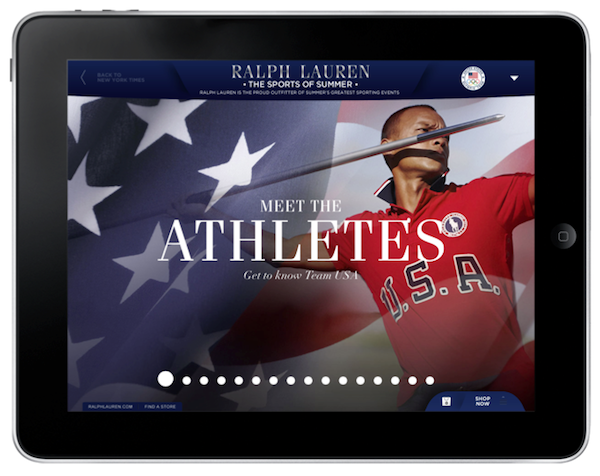

Good news for Olympics fans and New York Times readers: Much of the Times’ iPad app will be free to access for almost two weeks. For the second year in a row, Ralph Lauren is doing an ad takeover of the app. Just like last time, the free access it provides will be to some of the sections you might imagine the makers of Polo to be interested in: Sports, Fashion, Travel, Home & Garden, and T Magazine. The sponsorship is tied to the Olympics and will feature ads with U.S. Olympians, which will partner well with the Times’ special Olympics section. (Sorry, readers of in-depth national, international, or political news — that’ll still cost you.)
Along with some extra revenue, the deal gives the Times a new way to let readers sample their wares in the hopes of upselling them to a digital subscription. On the web, that sampling takes the form of the 10 free articles readers are allowed each month; in the Times’ iPhone and iPad apps, readers only get to sample an editor-selected group of top stories, with the rest locked behind the paywall. For iPad users, the Ralph Lauren deal gives them a new taste of some of the softer sections they might find appealing.
“It’s an opportunity for us to open up additional sections of content for people who have the app,” said Todd Haskell, group advertising director for the Times. According to a spokeswoman, the Times iPad app, which ranks in the top 5 free iPad apps for news, has seen more than 5 million downloads. The Times’ digital subscribers total only about one-tenth of that number, and many of those don’t have access to the iPad app, which costs more. That suggests there are plenty of people left to upsell.

The trade off for free access, in this case, is a selection of Ralph Lauren ads seeded throughout the app, on section fronts, in between article pages, and whenever the app is opened. But the ads in this case will be more sophisticated than a static image: The package includes video, features on Olympic athletes, and an e-commerce option should you find yourself interested in a $145 Team USA polo (er, Polo).
“When someone is in engaged in our Olympic content, they’ll be able to see our slideshow of the opening ceremonies and go into the Ralph Lauren environment in the app and purchase some of the apparel worn by athletes in the opening ceremonies,” Haskell said. “I think that’s a great advertising experience, I think that’s a great reading experience.”
Haskell said the results of the first ad sponsorship with Ralph Lauren last fall received good feedback from readers. “What we have seen is ads that do have immersive content, whether it’s a gaming element or additional slideshows or videos, they perform very well,” he said.
What the Times wants people to do is get to know the iPad app a little better by spending lots of time with it. The feature-y content in many of the newly free sections fits in well with the iPad’s lean-back environment. And by tying in the Olympics, the Times can also try to get in on some second-screen action as people watch events taking place in London.
The Times produces a lot of work on a daily basis and that leaves lots of entry points for new readers. Haskell said part of the idea behind the promotion is to expose people to parts of the Times they may be less familiar with. “When someone has the opportunity to read more, it emphasizes the fact we produce an enormous amount of content they may be interested in and might be worth their while to access all the time,” he said.